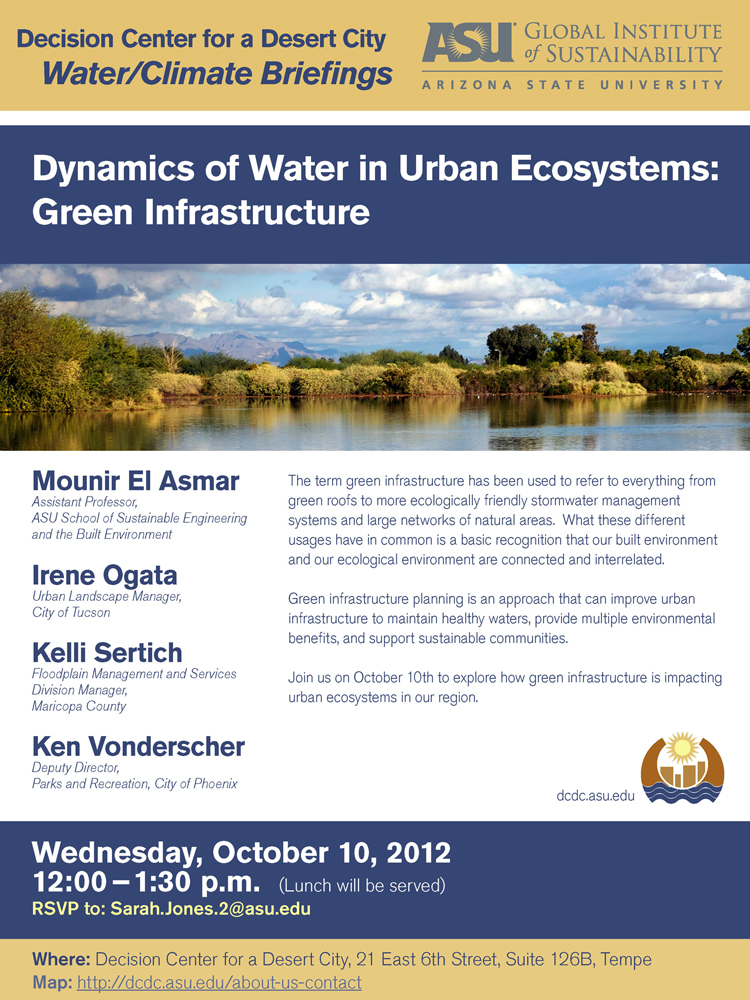by Dianna M. Náñez- Sept. 27, 2012
The Republic | azcentral.com
Critics say the Valley is among the nation's most unsustainable regions, warning that if the Phoenix metro area continues on its current path it will exhaust its resources and become a mirage in the desert.
On Tuesday, mayors from Phoenix, Mesa and Tempe fought that criticism, touting recent land-planning, conservation and preservation efforts to build a more sustainable region.
The mayoral panel, sponsored by Arizona State University's Global Institute of Sustainability at Mesa Arts Center, addressed sustainability challenges and opportunities for cities.
Addressing the audience of about 250 people, Mesa Mayor Scott Smith acknowledged that the Valley's expansive development is a "miracle in the desert." But he said that responsible land planning can ensure that the region will thrive for future generations.
Smith said Valley cities are working locally and regionally to build more sustainable environments.
That effort has grown in recent years as more residents and municipal leaders say it makes economic sense to conserve and develop sustainable land-use and transit plans.
The urban sprawl that spread throughout the Valley during the real-estate boom is not a sustainable model, he said.
"We've gotten a little lazy ... recognizing how fragile our lifestyle is," he said. "We can't continue (on this path) ... and expect us to remain a miracle in the desert."
Mesa now has city-development and sustainability officials work together to ensure that sustainability is factored into land-planning and growth opportunities.
Smith said it's important to boost downtown-infill projects because sprawling Valley municipalities can't afford to provide services across such widespread city boundaries.
Phoenix Mayor Greg Stanton shot back at one of the region's biggest critics, Andrew Ross, a professor of social and cultural analysis at New York University.
Ross's book, "Bird on Fire: Lessons From the World's Least Sustainable City," ripped the region for mismanaging the natural flows of the Salt River, for creating a sprawling overpopulated Mecca and for favoring commercial growth over sustainable growth.
Ross singled out Tempe's man-made Town Lake as a waste of precious water.
Stanton said he is not focused on Phoenix's standing in national sustainability rankings.
"I don't particularly care where my city is ranked next to Chicago," he said. "The question really is, are we doing all we can to advance sustainability?"
Stanton said that Phoenix has an ASU sustainability adviser providing input on land-planning, transit, and other growth and conservation issues.
He said Phoenix has boosted bus and light-rail options as transit alternatives to cars. He also touted historic-preservation and water-conservation efforts.
Stanton said he aims to brand Phoenix as a sustainable city to attract industries expanding or opening new businesses.
The mayors agreed municipalities must create regional-sustainability partnerships.
"The more we work regionally, the more success we'll have," Tempe Mayor Mark Mitchell said. Mitchell spotlighted Tempe's efforts to install energy-efficient street lights, a multi-modal transit system and a recycling program.
Noting Tempe's 175 miles of bike paths, Mitchell said the Valley should consider the benefits of creating a network of connecting bike paths, which would make bicycling a more viable option for people who want to ditch their cars.
Smith said Valley residents travel so much between cities that regional cooperation is essential.
"City lines only exist on maps anymore," Smith said.
The link to the article can be found here.
 Based on his work to develop and implement innovative approaches to teaching engineering, ASU faculty member and sustainability scientist Thomas Seager has been selected to participate in the National Academy of Engineering’s Frontiers of Engineering Education Symposium. Seager joins Jeffrey LaBelle from ASU's School of Biological and Health Systems Engineering and Aviral Shrivastava from ASU's School of Computing, Informatics, and Decision Systems Engineering.
Based on his work to develop and implement innovative approaches to teaching engineering, ASU faculty member and sustainability scientist Thomas Seager has been selected to participate in the National Academy of Engineering’s Frontiers of Engineering Education Symposium. Seager joins Jeffrey LaBelle from ASU's School of Biological and Health Systems Engineering and Aviral Shrivastava from ASU's School of Computing, Informatics, and Decision Systems Engineering.


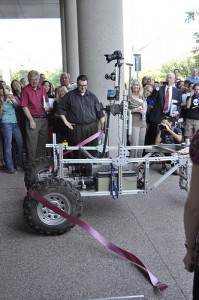 Wednesday, September 19, 2012 marked the grand opening of the Interdisciplinary Science and Technology Building IV (ISTB 4) on ASU Tempe campus. In celebration of this event, the Office of Knowledge and Enterprise Development (OKED) hosted a forum discussing how activities and research at ISTB 4 and ASU affect the local economy and state. The “Exploring the Economic Impact of Research in Arizona” forum hosted a renowned group of panelists that represented the fields of research that are now housed at the ISTB 4 building. OKED Senior Vice President, Sethuraman “Panch” Panchanathan, was the moderator of the forum and began with introducing each panelist as a representation of the three interdisciplinary topic areas to discuss: earth and space exploration, security and defense, and energy and sustainability.
Wednesday, September 19, 2012 marked the grand opening of the Interdisciplinary Science and Technology Building IV (ISTB 4) on ASU Tempe campus. In celebration of this event, the Office of Knowledge and Enterprise Development (OKED) hosted a forum discussing how activities and research at ISTB 4 and ASU affect the local economy and state. The “Exploring the Economic Impact of Research in Arizona” forum hosted a renowned group of panelists that represented the fields of research that are now housed at the ISTB 4 building. OKED Senior Vice President, Sethuraman “Panch” Panchanathan, was the moderator of the forum and began with introducing each panelist as a representation of the three interdisciplinary topic areas to discuss: earth and space exploration, security and defense, and energy and sustainability.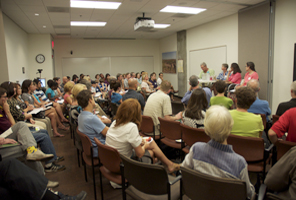 Beginning this academic year, you can find video of our Water/Climate Briefings on the DCDC website under each Water/Climate Briefing heading. We're excited about this opportunity to reach a broader audience with our ongoing research.
Beginning this academic year, you can find video of our Water/Climate Briefings on the DCDC website under each Water/Climate Briefing heading. We're excited about this opportunity to reach a broader audience with our ongoing research.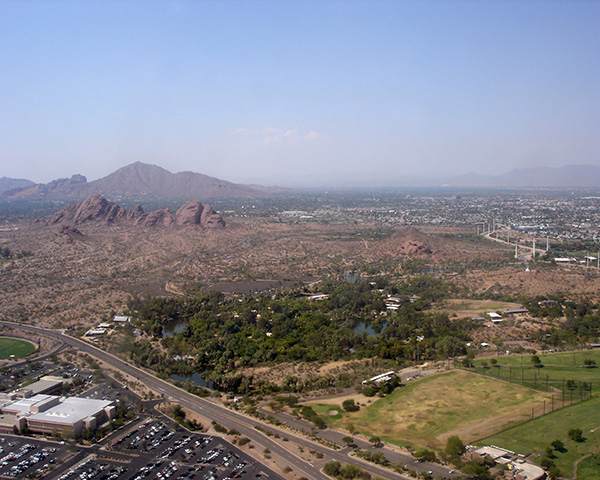
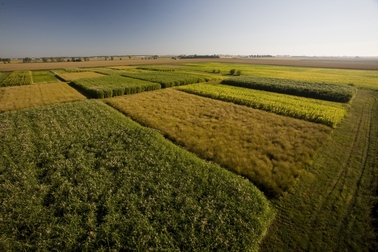 Arizona State University researchers will embark on a novel renewable energy project with support from the National Science Foundation (NSF) through its Water Sustainability and Climate program (WSC).
Arizona State University researchers will embark on a novel renewable energy project with support from the National Science Foundation (NSF) through its Water Sustainability and Climate program (WSC).
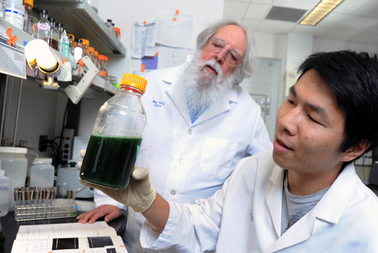 Perhaps inspired by Arizona’s blazing summers, Arizona State University scientists have developed a new method that relies on heat to improve the yield and lower the costs of high-energy biofuels production, making renewable energy production more of an everyday reality.
Perhaps inspired by Arizona’s blazing summers, Arizona State University scientists have developed a new method that relies on heat to improve the yield and lower the costs of high-energy biofuels production, making renewable energy production more of an everyday reality.
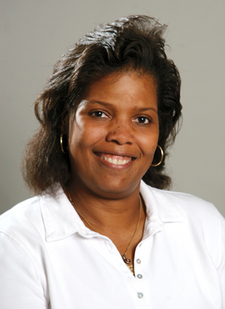 Arizona State University chemical engineer Jean Andino will share her expertise in renewable energy development with research colleagues and students in Panama with the support of a prestigious Fulbright U.S. Scholar award.
Arizona State University chemical engineer Jean Andino will share her expertise in renewable energy development with research colleagues and students in Panama with the support of a prestigious Fulbright U.S. Scholar award.
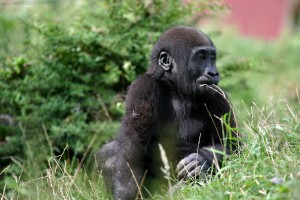
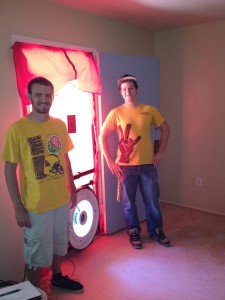
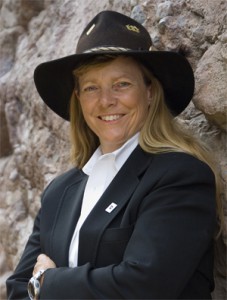
 It’s called mile-a-minute weed or “forest killer.”Mikania micrantha is an exotic, invasive species that spreads quickly, covering crops, smothering trees and rapidly altering the environment.
It’s called mile-a-minute weed or “forest killer.”Mikania micrantha is an exotic, invasive species that spreads quickly, covering crops, smothering trees and rapidly altering the environment.
 Several researchers at Arizona State University are examining the ethical aspects of food production and consumption. They are helping consumers navigate the maze of moral choices involved in filling their plates and their bellies. And they are finding that being morally mindful can lead to better nutrition, as well.
Several researchers at Arizona State University are examining the ethical aspects of food production and consumption. They are helping consumers navigate the maze of moral choices involved in filling their plates and their bellies. And they are finding that being morally mindful can lead to better nutrition, as well.
